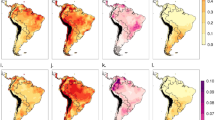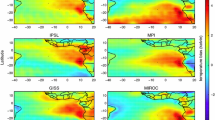Abstract
Analysis of variance (ANOVA) is a powerful statistical technique for making inferences about experiments that are influenced by multiple factors. Whilst common in many other scientific fields, its use within the climate community has been limited to date. Here we review the basis for ANOVA and how, in particular, it can be applied to partition the variance in a multi-model ensemble of Atmospheric General Circulation Model simulations. We examine an ensemble of four AGCMs forced with observed twentieth century sea surface temperatures (SST). We show that the dominant contributions to the total variance of seasonal mean sea level pressure arise from between-model differences (the bias term) and internal noise (the noise term). However, which term is most important varies from region to region. Of particular interest is the interaction term, which describes differences between the models in their responses to common SST forcing. The interaction term is found to be largest over the Indian Ocean (in all seasons), and over the subtropical Northwest Pacific in boreal summer. The differences between the model responses in these regions suggest differences in their simulation of atmospheric teleconnections, with potentially important implications, e.g. for seasonal predictions of the South and East Asian Monsoons. Examination of these differences may lead to an understanding of the reasons why models respond differently to common forcing, and ultimately to improvements in the performance of climate models.









Similar content being viewed by others
Notes
The analysis can still be performed if the models have a different number of ensemble members, K, but the statistical tests will no longer be exact. See von Storch and Zwiers (2002, p. 178).
It is worth noting at this point, that when t = 2 and m = 1 the ANOVA procedure will reduce exactly to a standard Student's t test between two samples, each of size k. See Scheffe (1959) Appendix 4.
For this test to be accurate, ε tmk must be a normally and independently distributed random variable. For seasonal-mean data, normality is a realistic assumption that follows from the central limit theorem. Additional checks using the estimator of ε tmk , given in Eq. 7 confirmed that ε tmk is independently distributed.
Is is also entirely possible to apply ANOVA to other spatial decompositions—e.g. using expansion coefficients of spatial modes—e.g. empirical orthogonal functions (EOFs), etc.
Other, less common methods also exist that do not rely on the assumption of Gaussian statistics (see for example Anderson and Stern 1996).
References
Allan R, Ansell T (2006) A new globally-complete monthly historical gridded mean sea level pressure data set (hadslp2): 1850–2004. J Clim 19:2717–2742
Anderson J, Stern W (1996) Evaluating the potential predictive utility of ensemble forecasts. J Clim 9:260–269
Conil S, Li Z (2003) Influence of the north atlantic on simulated atmospheric variability. Ann Geophys 46:57–67
Copsey D, Sutton R, Knight J (2006) Recent trends in sea level pressure in the indian ocean region. Geophys Res Lett 33. URL doi:10.1029/2006GL027175
Déqué M, Dreveton C, Braun A, Cariolle D (1994) The arpege/ifs atmosphere model: a contribution to the french community climate modelling. Clim Dyn 10:249–266
Hoel PG (1985) Introduction to mathematical statistics. Wiley (WIE), New York, iSBN: 0471805300
Houghton J, Ding Y, Griggs D, Noguer M, van der Linden P, Xiaosu D (2001) Climate change 2001: the scientific basis. Cambridge University Press, London
Lau N-C (1985) Modeling the seasonal dependence of the atmospheric response to observed el ninos in 1962–76. Mon Weav Rev 113:1970–1996
Li J-F, Koehler M, Farrara J, Mechoso C (2002) The impact of stratocumulus cloud radiative properties on surface heat fluxes simulated with a general circulation model. Mon Weav Rev 130:1433–1441
Moore DS, McCabe GP (2002) Introduction to the Practice of Statistics. W.H. Freeman, San Francisco, iSBN: 0716796570
Murphy J, Sexton D, Barnett D, Jones G, Webb M, Collins M, Stainforth D (2004) Quantification of modelling uncertainties in a large ensemble of climate change simulations. Nature 430:768–772. doi:10.1038/nature02771
Paeth H, Hense A (2002) Sensitivity of climate change signals deduced from multi-model monte carlo experiments. Clim Res 22:189–204
Palmer T, Alessandri A, Andersen U, Cantelaube P, Davey M, Délécluse P, Déqué M, Díez E, Doblas-Reyes F, Feddersen H, Graham R, Gualdi S, Guérémy J-F, Hagedorn R, Hoshen M, Keenlyside N, Latif M, Lazar A, Maisonnave E, Marletto V, Morse AP, Orfila B, Rogel P, Terres J-M, Thomson MC (2004) Development of a european multi-model ensemble system for seasonal to inter-annual prediction (demeter). Bull Am Met Soc 85:853–872
Pope V, Gallani M, Rowntree P, Stratton R (2000) The impact of new physical parametrizations in the hadley centre climate model: Hadam3. Clim Dyn 16:123–146
Rauthe M, Hense A, Paeth H (2004) A model intercomparison study of climate change in extratropical circulation. Int J Climatol 24:643–662
Rayner N, Parker D, Horton E, Folland C, Alexander L, Rowell D, Kent E, Kaplan A (2003) Global analyses of sst, sea ice and night marine air temperature since the late nineteenth century. J Geophys Res Atmos 108:4407. doi:10.1029/2002JD002670
Roeckner E, Bengtsson L, Feichter J, Lelieveld J, Rodhe H (1999) Transient climate change simulations with a coupled atmosphere-ocean gcm including the tropospheric sulfur cycle. J Clim 12:3004–3032
Roeckner E, Brokopf R, Esch M, Giorgetta M, Hagemann S, Kornblueh L, Manzini E, Schlese U, Schulzweida U (2006) Sensitivity of simulated climate to horizontal and vertical resolution in the echam5 atmosphere model. J Clim 19:3771–3791
Rowell DP (1998) Assessing potential seasonal predictability with an ensemble of multidecadal gcm simulations. J Clim 11:109–120
Scheffé H (1959) The analysis of variance. Wiley, New York
Shukla J, Gutzler D (1983) Interannual variability and predictability of 500 mb geopotential heights over the northern hemisphere. Mon Weav Rev 111:1273–1279
Shukla J, Anderson J, Baumhefner D, Brankovic C, Chang Y, Kalnay E, Marx L, Palmer T, Paolino D, Ploshay J, Schubert S, Straus D, Suarez M, Tribbia J (2000) Dynamical seasonal prediction. Bull Am Met Soc 81:2593–2606
von Storch H, Zwiers FW (2002) Statistical analysis in climate research. Cambridge University Press, London, iSBN: 0521012309
Sutton R, Hodson D (2005) Atlantic ocean forcing of north american and european summer climate. Science 309:115–118
Zwiers F (1987) A potential predictability study conducted with an atmospheric general circulation model. Mon Weav Rev 115:2957–2974
Zwiers F (1996) Interannual variability and predictability in an ensemble of amip climate simulations conducted with the ccc gcm2. Clim Dyn 12:825–847
Zwiers F, Wang X, Sheng J (2000) Effects of specifying bottom boundary conditions in an ensemble of atmosphere gcm simulations. J Geophys Res Atmos 105:7295–7315
Acknowledgments
This work was supported by European Union Framework 6 ENSEMBLES project (contract number GOCE-CT-2003-505539), DYNAMITE project (contract number 00393 (GOCE)-DYNAMITE), European Union Framework 5 PREDICATE project (contract number EVK2-1999-0020) and by the National Centre for Atmospheric Science (NCAS). R. T. Sutton is supported by research fellowship from the Royal Society. We are grateful to Holger Pohlmann (MPI) for the Echam4 experimental data, Mark Rodwell (ECMWF) for the HadAM3 experimental data, Martin Stendel (DMI) for the Echam5 experimental data, Laurent Terray (CERFACS) for the Arpege experimental data, and to our colleagues at The Met Office Hadley Centre for allowing the use of HadSLP2 and HadISST. We would also like to thank two anonymous reviewers for their suggested improvements to this paper.
Author information
Authors and Affiliations
Corresponding author
Rights and permissions
About this article
Cite this article
Hodson, D., Sutton, R. Exploring multi-model atmospheric GCM ensembles with ANOVA. Clim Dyn 31, 973–986 (2008). https://doi.org/10.1007/s00382-008-0372-z
Received:
Accepted:
Published:
Issue Date:
DOI: https://doi.org/10.1007/s00382-008-0372-z




